PinotFile: 9.16 December 10, 2012
|
Kutch: Dedicated Work in Vineyards Made Difference in 2011I first profiled Jamie Kutch in May 2005 after our first meeting (“Following Your Pinot Dream”, www.princeofpinot.com/article/235/). He was a greenhorn winemaker, an escapee from a lifetime in New York City and a tedious job at an investment bank, learning the vintner’s craft at the side of Michael Browne of Kosta Browne. Upon the encouragement from others who had left high-profile jobs to pursue winemaking careers such as Andrew Vingiello (A.P. Vin) and Brian Loring (Loring Wine Company), as well as Michael, he had quit his job, talked his girlfriend into accompanying him, and moved to San Francisco to work in the nearby wine industry. In 2006, Jamie moved his production to Deerfield Ranch Winery in Sonoma Valley where Michael Browne first gained his winemaking experience under managing partner Robert Rex. Relying on his own resources and a loan from his father, Jamie launched his eponymous label, Kutch, and became an independent producer with no investors or employees. He crafted an Amber Ridge Vineyard Russian River Valley Pinot Noir, a McDougall Ranch Sonoma Coast Pinot Noir, and a Sonoma Coast Pinot Noir Rosé from the 2006 vintage. Before long, James Laube of the Wine Spectator, and other publications found Kutch’s story compelling, and considerable national publicity for his wines ensued. The first vintages were decent, but not riveting, and this was understandable as Jamie had little winemaking experience. He was obviously bright and passionate about making Pinot Noir, and caught on quickly after eagerly seeking out the advice of well-known Pinot Noir winegrowers and winemakers. He tasted hundreds of old California and Oregon Pinot Noirs, traveled to Burgundy on several occasions, and consumed as much Burgundy as possible to guide him in making his vinification choices. From the beginning, Jamie was aware of the importance of obtaining premium vineyard sources for his wines, and sought out cool climate sites in the North Coast of California that he considered ideal for Pinot Noir. He also realized quickly that the growing cycle in California vineyards did not need to be prolonged since excessive hang time led to a loss of purity, freshness and brightness in the resultant wines. He turned to careful crop management and minimal irrigation toward the end of the growing cycle, finding that phenolics became ripe naturally at lower Brix. Jamie only works with vineyards where he can become significantly involved in the farming and ones that allow him to buy by the acre. 2011 was the last vintage with Savoy Vineyard since placement in the vineyard and the farming and watering regime did not meet his lofty ideals. Jamie hit the mark with his 2009 vintage Pinot Noirs. The very cool 2010 vintage was much more challenging and the wines, though good, were not as stellar. Applying the viticulture lessons he learned in 2010, he intensified his work in the vineyards in the similarly cool 2011 vintage, and notes, “In what many felt was a difficult vintage, we really made some amazing wines due to massive work in the vineyards.”
 In 2012, Jamie moved into a new winery in Sonoma located on 8th street east, just south of the Sonoma Square. He bought 30 new tanks and processed a total of 58 tons or 3200 cases in 2012, a significant increase in production. Also in 2012, Jamie found a new fruit source in Hirsch Vineyard, working as he put it, very closely with David Hirsch. He now obtains more fruit from the esteemed McDougall Ranch (he shares this vineyard with Dan Goldfield of Dutton-Goldfield).
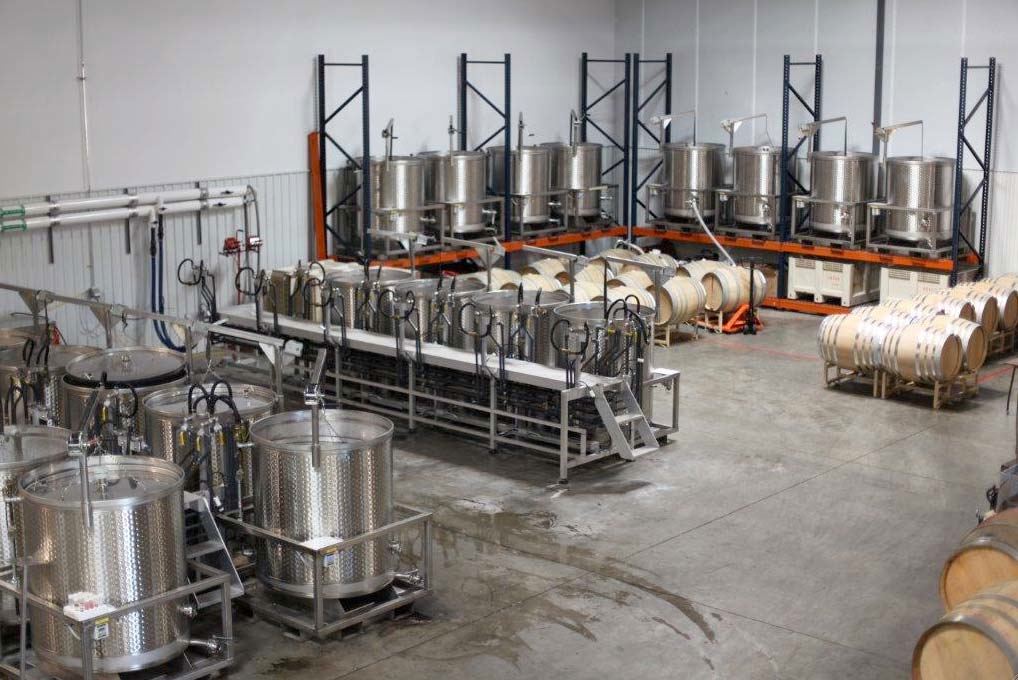 Practically all Kutch wines production is sold directly through a mailing list at www.kutchwines.com. Because of the increasing production, the list is still open. The winery is not open to the public. Jamie does not participate in large Pinot Noir events, believing that serious appreciation of the wines is not possible under the frenetic circumstances of this large venues. Look for him at the more intimate third annual Pursuit of Balance tastings in San Francisco, February 4, 2013, and/or Los Angeles, February 6, 2013 (visit www.inpursuitofbalance.com). The reviews that follow are among the first to appear for the 2011 Kutch Pinot Noir wines. The mailing list members have not received offerings yet. Release dates are February 2013 for the Sonoma Coast and Savoy Vineyard Anderson Valley bottlings, and August 2013 for the McDougall Ranch and Falstaff wines from the Sonoma Coast. These are ridiculously good wines and I encourage you to join the mailing list to grab a few bottles before the word gets out.
2011 Kutch Sonoma Coast Pinot Noir 12.8% alc., 1,160 cases, $39. Release February 2013. 7-day cold soak, native fermentations, 75% de-stemmed (twice daily punch down) and 25% whole cluster (crushed by foot), gravity movement of all wine, aged sur lie 10 months in 30% new and 70% used French oak barrels. · Moderate reddish-purple color in the glass. Beguiling aromas of black cherries, clove, nutmeg, orchid and redwood cask with aromas dancing in and out over time in the glass. Earthy flavors of black cherries, plums and black raspberries with a hint of oak anise in the background. Not the finish of the vineyard-designates, but very appealing now. Still fine the following day from a previously opened and re-corked bottle. Very good.
2011 Kutch Savoy Vineyard Anderson Valley Pinot Noir 12.9% alc., 245 cases, $55. Release February 2013. 7-day cold soak, native fermentations, 50% de-stemmed (twice daily punch downs) and 50% whole cluster (crushed by foot), aged sur lie 10 months without racking in 100% neutral oak. · Moderately light garnet color in the glass. Aromas of dark red fruits, rose petals, jasmine, fruit leather. Moderately rich essence of black raspberries with an earthy soul. Caressing tannins, very smooth and polished, with some delicacy, finishing with uncommon persistence without weight. Very good (+).
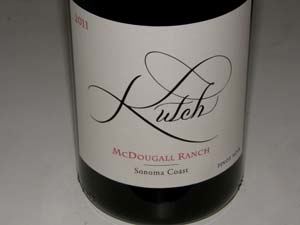 2011 Kutch McDougall Ranch Sonoma Coast Pinot Noir 13.6% alc., 345 cases, $55. Release August 2013. 7-day cold soak, native fermentations, 50% de-stemmed and 50% whole cluster, all fruit crushed and punched down by foot, aged sur lie for 10 months without racking in 50% new and 50% used French oak barrels. · Moderately light reddish-purple color in the glass. Striking nose offering extroverted scents of black cherries, spice, briar and rose petal. Mouth watering flavors of ripe black cherries and dark red berry jam, with a joyful hint of spice. Very soft and smooth, almost ephemeral, but with eye-opening fruit intensity. There is an extra depth of flavor on the finish that keeps rolling along just when you think it must be finally done. I was really taken by this wine, and as I sat in my chair, I kept looking at the glass and shaking my head in wonderment. Even better the following day from a previously opened and recorked bottle. Similar in some ways to the great 2009 vintage of this wine, but more approachable and elegant in style.
 2011 Kutch Falstaff Vineyard Sonoma Coast Pinot Noir 12.7% alc., 50 cases, $55. Release August 2013. 7-day cold soak, native fermentations, 50% de-stemmed and 50% whole cluster, all fruit crushed and punched down by foot, aged sur lie 10 months without racking in 50% new and 50% used French oak barrels. · Moderately dark reddish-purple color in the glass. The nose picks up intensity and interest over time in the glass, slowly revealing attractive aromas of blackberries, black raspberries and candied plum. Intensely fruity on the attack and mid palate, the broad flavors finishing with impressive length. Deep plum and dark berry flavors caressed in supple tannins with a velvety smooth mouth feel. A very subtle stem note in the background disappears and the flavors really blossom the following day from a previously opened and re-corked bottle. Give this wine some time in the cellar and you will be a happy camper.
Maggy Hawk: Anderson Valley’s Rugged and Remote Outpost of Exceptional Pinot Noir
This 58.7-acre estate is hidden away in the Anderson Valley’s deep end among coastal redwoods at elevations rising from 300 to 500 feet. For those familiar with the Valley, the vineyard is located west of the Rock Shop on Highway 128. A remote, fog-cloaked, and wind-swept setting, the site is unique for its complex array of steep slopes and facings and well-drained, porous, decomposed sandstone soil. Maggy Hawk winemaker, Elizabeth Grant-Douglas, revers the property, calling it her “favorite place on earth,” and “heavenly.”
Maggy Hawk Vineyard has no neighbor issues to affect farming of the vineyard. No intensive viticulture techniques are required as the vines are largely self-regulating and typically produce yields of less than two tons per acre of beautiful fruit. That’s not to say that there are no challenges in farming this site. Dramatic winds are common, and vines struggle throughout the season, threatened by early rains and frost, and ripening so slowly that the vineyard demands patience. Maggy Hawk Vineyard was planted in 2000 to 23.55 acres of distinct blocks with a variety of clones including Pommard, Wädenswil 2A, and Dijon 115, 667 and 777, principally on rootstocks 3309C and 101-14. The vine spacing is 8‘ x 5‘ to 9‘ x 5’, with 978-1102 plants per acre on a VSP trellis with bilateral cordon. The vineyard manager, Dennis Winchester lives on the property. Maggy Hawk is the name of Barbara Banke’s favorite, winning thoroughbred horse. Banke was a lawyer and wine connoisseur when she met Jess Jackson and played a major role in the growth of Jackson Family Wines. She assumed the reigns of Jackson Family Wines when Mr. Jackson passed away in 2011. She established the Maggy Hawk label with the inaugural release in 2007. Before that, grapes from the Maggy Hawk Vineyard had become an important component of the La Crema Anderson Valley bottling beginning in 2003. In 2006, there was a bumper crop of more than three tons per acre from the vineyard and two La Crema Maggy Hawk Pinot Noirs were vinified (No. 5 Block and Blend) by the La Crema winemaker at the time, Melissa Stackhouse. The following year the Maggy Hawk label debuted and three wines were produced by winemaker Elizabeth Grant-Douglas (also the winemaker at La Crema, pictured below), each named after a horse born to the mare Maggy Hawk: Jolie, Afleet, and Stormin’. Afleet was a Preakness and Belmont Stakes winner. With the 2009 vintage, four wines were produced, each named after the horses born to the mare including Jolie, Afleet, and Unforgettable, and to her sire - Hawkster. The wines are all made from predominantly single clones from a specific block within the vineyard.
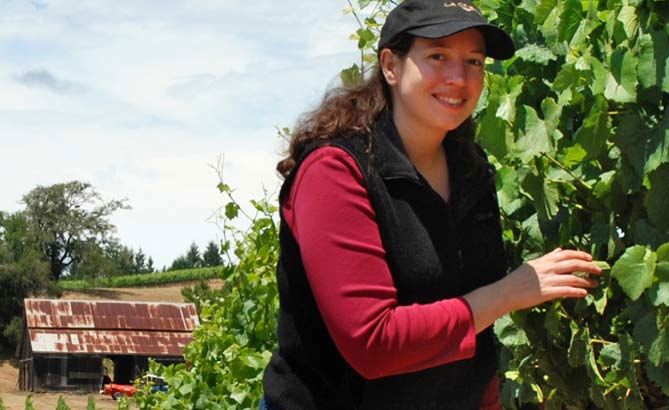 Grapes were harvested October 5, 6, and 7, 2009, following a relatively cool, even growing season. Yields were 1.85 tons per acre for Unforgettable block, 2.21 tons per acre for Afleet block, 2.30 tons per acre for Jolie block, and 2.44 tons per acre for Hawkster block. The wines received a 5-day cold soak followed by fermentations driven by indigenous and proprietary yeasts. The wines were aged in 23%-35% new French oak barrels for 15 months. The 2007 Maggy Hawk Pinot Noirs were stunning wines, reviewed in January 2012 in the PinotFile (www.princeofpinot.com/article/1169/). At the time, my comment was, “The trio of 2007 Maggy Hawk Pinot Noirs are vinous treasures of uncommon pedigree much like their namesakes. They are truly special connoisseur’s wines that defy appropriate description.....possessing a somewhereness that sets them apart.” The 2009 Maggy Hawk wines were first offered for tasting at the Anderson Valley Pinot Noir Festival where I again was quite taken by their uniqueness. A mailing list signup was offered at that Festival. Visit the website at www.maggyhawkwines.com to join the mailing list (info@maggyhawkwines.com). The complete website will launch in January.
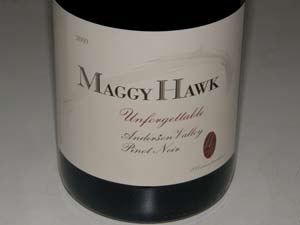 2009 Maggy Hawk Afleet Anderson Valley Pinot Noir 14.6% alc., pH 3.53, TA 0.52, 234 cases, $66. From 1.23-acre Block 4, Pommard clone. Aged 15 months in 32% new French oak barrels. · Moderately dark reddish-purple color in the glass. Haunting aromas of spiced black cherries and black raspberries creating an olfactory overload. Richly endowed, with flavors of very ripe dark cherries, berries, currants and sassafras enveloping the palate. An appealing wood spice and savory herbal note add interest. Well-managed tannins create a round, polished drinking experience. Very typical Pommard-based wine that is the richest in the lineup. Still opulent the following day from a previously opened and re-corked bottle.
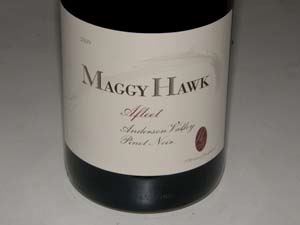 2009 Maggy Hawk Unforgettable Anderson Valley Pinot Noir 14.5% alc., pH 3.70, TA 0.51, 235 cases, $66. From 2.64-acre Block 5, clone 667. Aged 15 months in 35% new French oak barrels. · Very interesting woodsy nose offering aromas of black cherries, spice and mushrooms on the grill. Delicious core of fresh black raspberry and blackberry fruit, nicely spiced. A veritable iron fist in a velvet glove wine with rich, strikingly intense flavor, countered with seductive elegance and silkiness. Flat-out great the following day from a previously opened and recorked bottle. The name of this wine really fits.
2009 Maggy Hawk Jolie Anderson Valley Pinot Noir 14.6% alc., pH 3.62, TA 0.55, 237 cases, $66. From 10.03 acre Block 7, clone 115. Aged 15 months in 23% new French oak barrels. · Moderately dark reddishpurple color in the glass. Showy aromas of red cherries and raspberries with a hint of forest floor, compost and oak. Lushly flavored yet sleek and seductive with a core of deep raspberry flavor complimented by a whisper of oak. A pretty wine yet endowed with good structural bones, finishing long and opulent. Still solid the following day from a previously opened and re-corked bottle. Very good (+).
2009 Maggy Hawk Hawkster Anderson Valley Pinot Noir 15.4% alc., pH 3.57, TA 0.54, 240 cases, $66. From Blocks 12, 13, and 14, 6.18 acres, clone 2A. Aged 15 months in 32% new French oak. · Medium reddishpurple hue in the glass. Very ripe fruit-driven wine offering aromas of black plum sauce, blackberry jam, and spice, intensifying over time in the glass. Moderately rich with very ripe fruit flavors of red and black berries and slight prune. Sturdy tannins with complimentary oak in the background. More fruity and spicy the following day with a softer mouth feel. Tasted twice. Pushes the ripeness envelope too far for me. Good.
Stars Aligned for Sea Smoke in 20102010 was a very cool vintage in the Sta. Rita Hills, but as winemaker Don Schroeder said, “It played out really well in our vineyard. The yields were 1.8 tons per acre, which is close to our sweet spot, and though there were a couple of heat spells, the temperatures never really got above the mid-90s. At the same time, we had less lingering fog in 2010, so even though it was overall a cool growing season, we received more sunshine.” Sea Smoke ended up harvesting its grapes earlier than normal in 2010 and Schroeder was quite excited about the vintage. “Everything came in perfectly. When we tasted through the fermentations right after dryness, we commented that we could have put the wines in bottle right then. They were full, soft and incredibly aromatic.” Sea Smoke Estate Vineyard, 105 acres planted to ten clones of Pinot Noir in 26 unique blocks, is located on south-facing hillside bluffs at 300 to 700 feet above sea level in the Santa Rita Hills AVA. It benefits from the shallow clay soils and a moderating microclimate featuring the eponymous “sea smoke” marine fog layer that regularly travels up the Santa Ynez River canyon.
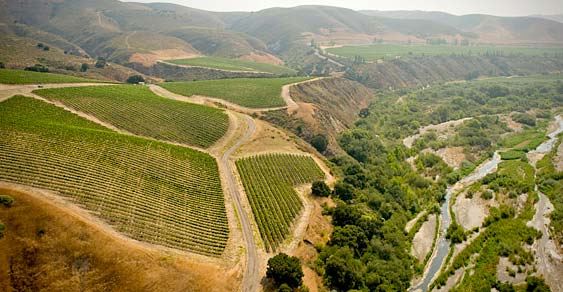 The style of Sea Smoke Pinot Noir has evolved over the years. With the completion of a good-size winery in Lompoc in 2009, ever-smaller lots can be vinified separately to preserve the character and complexity of different block and clonal combinations. In 2010, the winery undertook approximately 50 Pinot Noir fermentations, keeping them separate for almost a year of aging, at which point each barrel was graded and evaluated for as many as ten stylistic hallmarks. This meticulous approach, along with a dedicated effort to moderate extraction, slightly reduce alcohol levels, and finessed new oak ratios during barreling has led to a more welcoming style upon release without sacrificing age ability. The reference to Sea Smoke Pinot Noir as a “female bodybuilder” of a wine that was used by one writer in the past can be put to rest. For the estate-grown Pinot Noir, the following winemaking regimen was employed. Clusters were sorted in the vineyard and then gently de-stemmed following an evening in the winery’s cold room. All “jack stems” were removed on the sorting table. Musts were cold soaked in open-top fermenters for 1 to 4 days, then inoculated with cultured yeasts to begin slow fermentation. Each tank was manually punched down one to three times a day, with a total maceration time of 16 to 28 days. Upon completion of primary fermentation and maceration, all free run wine was transferred to tank for settling. Pressing was carried out at extremely low pressure to avoid extracting bitterness from the seeds. After settling overnight, both free run and press wines were racked to barrels and aged 16 months. About 20 different types of barrels were used and each year the best cooper, clone and block combinations are continually being refined. The estate-grown Chardonnay was vinified as follows. Chilled grapes were softly pressed and gently pumped into a stainless steel tank for cold settling. Once the heavy solids were removed, the juice was racked to both French oak barrels and stainless steel fermenter, then inoculated for primary fermentation. Following primary fermentation, the wine was inoculated for malolactic fermentation and barrels were periodically stirred to enhance depth and mouth feel. Some wine was aged in large-format 600-liter demi-muids. The wine was aged 16 months in 55% new French oak barrels before bottling. The 2010 Sea Smoke wines are extraordinary, the best I have ever sampled from this winery. Of the two wines reviewed here, the 2010 Southing Pinot Noir features a complex and elegant expression of Sea Smoke Vineyard Pinot Noir, while the 2010 Ten Pinot Noir possesses more power and extraction. Both wines display the prominent acidity that typifies Sta. Rita Hills wines. The Pinot Noirs are quite approachable now, especially with decanting, and the impeccable balance predicts a long life in the cellar. Five wines were produced in 2010, three of which are reviewed here. Omitted are the 2010 Sea Smoke Botella Pinot Noir and the 2010 Sea Smoke Gratis Chardonnay. Sea Smoke wines are sold almost exclusively through a mailing list and are highly allocated. Visit the website at www.seasmoke.com to join the list. No tasting room is available. The wine is not open to the public for tours, and vineyard visits are not available due to legal restrictions on public access.
2010 Sea Smoke Southing Sta. Rita Hills Pinot Noir 14.42% alc., pH 3.36, 0.7, $59 (Magnums $124). Released Octobers 2012. Exclusively Sea Smoke Estate Vineyard. Aged 16 months in 55% new French oak barrels. · Medium dark purple color in the glass. Well-endowed with seductive aromas of spice plum and dark red rose petals. Clearly a special wine that is very charming now. Discreetly concentrated flavors of plum, boysenberry and black cherry with a whisper of spice and vanilla, finishing with an intensely aromatic black cherry flourish. Beautifully composed with balanced tannins and welcoming acidity. A complete wine. Still impressive the following day from a previously opened and recorked bottle.
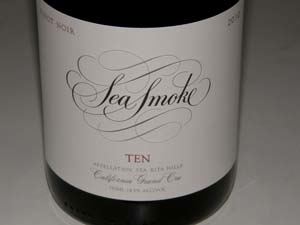 2010 Sea Smoke Ten Sta. Rita Hills Pinot Noir 14.65% alc., pH 3.38, TA 0.69, $82. Released October 2012. Ten clones (113, 115, 459, 667, 777, 09, 16, Pommard 5, 2A, and Mt. Eden selection) exclusively from Sea Smoke Estate Vineyard. Aged 16 months in 65% new French oak barrels. · Dark purple color in the glass. Very muted nose, opening very grudgingly to reveal aromas of fresh dark berry preserves. Similar in flavor to the Southing but showing more intensity, featuring dark red and black berries and cherries with an echo of oak. Rather unexpressive now but the potential is obvious. Very polished with well-managed ripe tannins and bright acidity. Spectacular the following day from a previously opened and recorked bottle, displaying flamboyant aromas of spicy berries, a creamy texture and a long, powerful finish. Cellar this sumptuous wine for several years.
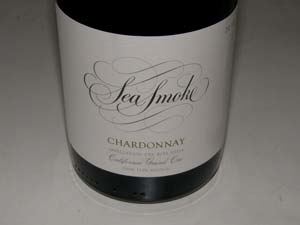 2010 Sea Smoke Sta. Rita Hills Chardonnay 14.6% alc., pH 3.37, TA 0.68, $59. Released October 2012. Exclusively Sea Smoke Estate Vineyard. Predominantly Wente clone with smaller amounts of Dijon clones 76, 95 and 96. Aged 16 months in 55% new French oak barrels. · Light straw color and clear in the glass. A majestic, full-on California style Chardonnay. Aromas of lemon curd, butter brickle, and roasted nuts. Richly flavored with notes of citrus, baked pear, and toasty oak complimented by clean, crisp acidity. Sta. Rita Hills is not just Pinot Noir country, for its Chardonnays typically offer incredibly lush, chewy, hi-tone fruit backed by generous, defining acidity. For those who relish this style of Chardonnay, it doesn’t get any better.
Paul Mathew Vineyards: Charming Russian River Valley Pinot NoirMat Gustafson has a great smile and knows how to craft smile-worthy Pinot Noir. His initial career path was in the hospitality industry managing restaurants in Michigan. He then moved to Colorado, and while attending the University of Colorado, he worked as a sommelier at the Flagstaff House Restaurant in Boulder. The restaurant had a wine cellar worthy of a Grand Award from the Wine Spectator, and he was able to taste many of the finest wines in the world. After graduation from the University of Colorado, he moved to Napa Valley to pursue a job in the wine industry. He eventually became a wine buyer and sommelier at John Ash & Co. Restaurant in Santa Rosa where he developed a passion for Russian River Valley Pinot Noir. He opened the Oakville Grocery in Healdsburg as the wine buyer, but soon decided he true calling was making wine. Mat began crafting wine while developing vineyards in western Sonoma County, working at Sebastopol-Dutton Estate Winery. He gained experience under Merry Edwards, who was the consulting enologist for the winery. In 2000, he became head winemaker at Sebastopol-Dutton Estate Winery, and remained in that position until 2009. He then left to become co-winemaker at Moshin Vineyards where he currently oversees all custom crush activities and makes the Paul Mathew Vineyards wines. Paul Mathew Vineyards was launched in 1999 with partner Paul Sloan who hasn’t been involved since 2001. Initially the wines were made at the Dutton’s facility. The partners’ first names were conjoined to form the name of the winery. Winemaking at Paul Mathew Vineyards is low input, using only native yeast fermentation and natural malolactic fermentation and minimal S02 in barrel. The wines are bottled without fining or filtering. Production at Paul Mathew Vineyards is modest, not exceeding 2,000 cases annually. Mat maintains 100% control of the fruit, producing high quality wines that are hand sold by people Mat and his spouse, Barb, enjoy doing business with. Barb is a former sommelier with the Four Seasons Hotels & Resorts who met Mat at the Russian River Valley Pinot Forum in 2004 and is now in charge of sales and marketing as well as assisting with farming, harvest and blending as needed. The couple really know the Russian River Valley. A tasting room opened in Graton in West Sonoma County in November 2012 that is open to the public Friday through Sunday and Monday through Thursday by appointment. Paul Mathew wines are also sold through a mailing list and limited retail channels. Visit the website at www.paulmathewwines.com.
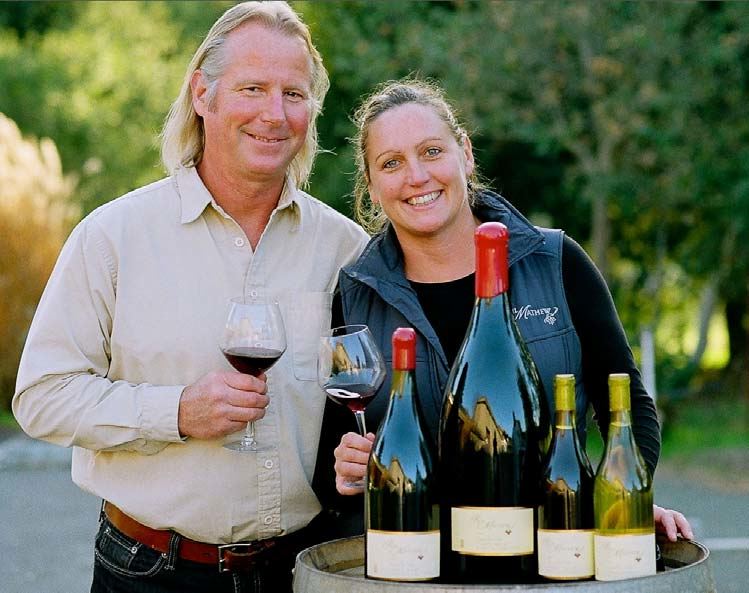
2010 Paul Mathew PM Vineyards Russian River Valley Pinot Noir 14.3% alc., pH 3.75, TA 0.54, 404 cases, $32. Released November 1, 2012. A blend of grapes from TNT, Ruxton and Horseshoe Bend vineyards which are all within a five mile area close to Occidental Road west of Sebastopol. Multiple Dijon clones. Aged 10 months in 32% new French oak barrels. · Medium reddish-purple color in the glass. Lovely perfume of fresh Bing cherries, sandalwood and sweet pipe tobacco smoke. Light on its feet with pleasing middleweight cherry flavor, offering well-integrate oak accents, soft tannins, but finishing a touch shallow. A well-balanced, comforting, easy to like wine. Good (+).
2010 Paul Mathew Ruxton Vineyard Russian River Valley Pinot Noir 13.5% alc., pH 3.79, TA 0.56, 139 cases, $45. Released November 1, 2012. This vineyard is on the western edge of the Green Valley AVA. Goldridge soil. Dijon clones 667, 777 and 115. Aged 10 months in 50% new French oak barrels. · Moderate reddish-purple color in the glass. Very seductive nose displaying bright aromas of dark red cherries and berries, musk and spice. On the lighter side but charming, with flavors of dark red cherries and cola, sporting supple tannins, and offering crisp acidity on the finish. A seamless wine with enough spirit and flavor to satisfy. Very good.
2010 Paul Mathew TNT Vineyard Russian River Valley Pinot Noir 14.3% alc., pH 3.81, TA 0.56, 188 cases, $45. Released November 1, 2012. This Green Valley vineyard was planted in 1999 and 2000 with clones 114, 115, 667 and 777 on Riparia Gloire rootstock in Goldridge soil. Aged 10 months in 50% new French oak barrels. · Moderately light reddish-purple color in the glass. Enticing aromas of berry jam on toast. Mouth filling, hearty flavors of black cherries and black raspberries implode on the mid palate with aplomb, lingering with a cherry and sassafras driven finish that is memorable. My notes say, “This is really good.” Fine the next day from a previously opened and re-corked bottle.
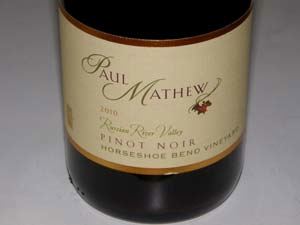 2010 Paul Mathew Horseshoe Bend Vineyard Russian River Valley Pinot Noir 14.1% alc., pH 3.76, TA 0.59, 114 cases, $45. Released November 1, 2012. This vineyard was planted in 1996 in Goldridge soils. Dijon 113. Aged 10 months in 50% new French oak barrels. · Light reddish color in the glass. The most aromatic wine in the lineup with high-spirited aromas of cherries, cranberries and rhubarb. Relatively light in weight but highly flavorful. Plenty of pinot singing in this wine with delicious spiced red plum, raspberry and cherry flavors. A bit unusual tasting in a good way. Well-rounded with supple tannins, a good cut of acidity, subtle oak in the background, and a finish that will not let go. Not as loaded as the TNT bottling, but equally satisfying.
More Sips of Pinot
These small lot wines are the result of the farming approach of noted vineyardist Ulises Valdez and the uncompromising winemaking of Leslie Sisneros. The Mononi and Toboni vineyard bottlings demonstrate the power of terroir since the two sites at the intersection of Olivet Road and River Road are separated by only a few hundred yards yet yield distinctly different wines. Beginning January 1, 2013, the new winemaker at Arista will be Matt Courtney, who has spent the past seven years at Marcassin Winery. The change was needed to have a winemaker who could devote their full-time energies to Arista. Leslie has her own label, Ispiri Wines.
2010 Arista Ferrington Vineyard Anderson Valley Pinot Noir 14.4% alc., pH 3.58, TA 0.61, 216 cases, $58. Released fall 2012. From a 25-acre vineyard just off Highway 128 in Booneville. 100% Pommard clone. Aged in 45% new, 11% 1-year and 44% 2-3-year-old French oak barrels. · Moderately dark reddish-purple color in the glass. The nose starts out with aromas of cherries, cherry skins, stem and smoky oak, evolving over time to reveal aromas of cherries, parchment and dried herbs. Appealing core of black cherry fruit with an earthy, herbal underbelly. Tastes of the soil. Lovely fruit backed by very firm tannins, finishing with a touch of citrusy acid. Still good the following day from a previously opened and re-corked bottle. Good.
2010 Arista Perli Vineyard Mendocino Ridge Pinot Noir 14.5% alc., pH 3.80, TA 0.60, 240 cases, $52. Released summer 2012. The Perli Vineyard was planted in 2001 and is owned and farmed by Steve Alden. 2200 feet elevation, about 6 miles inland. Aged in 40% new, 20% 12-year and 40% 2-3-year-old French oak barrels. · Moderately dark reddish-purple color in the glass. Very shy initially, opening up beautifully over time to reveal seductive aromas of dark berry jam, pumpkin pie spice, and raisin. Dark red fruits including strawberries and raspberries are featured with a little blueberry and pomegranate in the mix. A hint of clove and oak adds interest. Elegant and creamy in the mouth with good tannin integration. Very good.
 2010 Arista Toboni Vineyard Russian River Valley Pinot Noir 14.5% alc., pH 3.76, TA 0.54, 250 cases, $60. Released spring 2012. 15-acre vineyard planted to Dijon 115, 667 and 777, and Pommard 5. Mary and Joe Toboni are fourth generation San Franciscans whose roots can be traced back to San Francisco as early as the 1870s and to Sonoma County before the 1920s. Aged in 41% new, 33% 1-year and 26% 2-3-year-old French oak barrels. · Moderately dark reddish-purple color in the glass. Aromas of very ripe Bing cherries, black raspberries, and grilled plums. Deep black cherry and dark berry flavor with an underpinning of toasted oak and cola. Moderately rich with well balanced tannins and a silky mouth feel. Needs more time to shed some of the toasty oak on the finish. More intense cherry flavor the following day from a previously opened and re-corked bottle. Very good.
2010 Arista Mononi Vineyard Russian River Valley Pinot Noir 14.4% alc., pH 3.75, TA 0.53, 240 cases, $58. Released fall 2012. A 10-year-old vineyard planted to Dijon 113 and 115. Aged in 40% new, 50% 1-year and 10% 2-3-year-old French oak barrels. · Medium reddish-purple color in the glass. An earthy, savory wine offering aromas of dark berry preserves, herbs and oak. Moderately rich core of blackberries, black raspberries and black plums. Juicy, with good structural bones, and a long fruit and oak driven finish. Pushes the ripeness envelope but never crosses over. Very good.
2010 Arista Harper’s Rest Estate Grown Russian River Valley Pinot Noir 14.2% alc., pH 3.77, TA 0.60, 90 cases, $60. Released fall 2012. 2.1-acre vineyard planted in 2007. Clay loam soils. Pommard clone on 101-14 rootstock, 3.5’ x 7’, yields 1.25 tons per acre. Aged in 17% new, 33% 1-year and 50% 2-3-year-old French oak barrels. · Medium reddish-purple robe in the glass. The nose starts out promising with aromas of fresh dark cherries and raspberries but becomes somewhat dull over time with hints of briar and stem. Black cherry and dark red berry flavors are featured with a subtle green note in the background. Moderately intense with a creamy texture and long finish. This wine should improve over time. Good.
2010 Arista Two Birds Estate Grown Russian River Valley Pinot Noir 14.2% alc., pH 3.72, TA 0.58, 170 cases, $68. Released fall 2012. 3.1-acre vineyard planted in 2007. Clay loam soils. Pommard clone, Swan and Calera selections on 101-14 rootstock, 3.5’ x7’, yields 1.25 tons per acre. Aged in 37% new, 13% 1-year and 50% 2-3-year-old French oak barrels. · Medium reddish-purple color in the glass. Aroma of dark berry pie filling. Not particularly expressive now, with modest flavors of an array of dark red and black berries. A little earthy, a little spicy. The most tannic of all the Arista Pinot Noirs reviewed here. Slightly more definition of fruit, more finish and more character than the other estate wine, Harper’s Rest. Needs time to soften the tannins and come together. Good (+).
The fall offerings included a quartet of single vineyard Pinot Noirs from Ritchie, Reuling, UV and UV-SL vineyards. Aubert produces a decadent, lush, high-alcohol, fruit-driven style of Pinot Noir. I wrote about the winery in a previous issue (www.princeofpinot.com/article/837/). The wines are very well made for this style. Aubert’s vineyard manager is Ulises Valdez. A tasting salon opened at 333 Silverado Trail in Calistoga in September 2012, after extensive remodeling of the former August Briggs winery. Aubert customers are able to visit the winery and taste both new releases and library wines by appointment. A Sonoma Coast appellation Chardonnay was also released in 2012, the first appellation-designated Aubert offering.
2010 Aubert UV Vineyard Sonoma Coast Pinot Noir 15.3% alc., $80. · Medium reddish-purple color in the glass. The nose highlights blackberry and black plum fruit with a noticeable oak contribution. Soft and smooth with generous flavors of blackberries and black plum sauce accented with hints of oak spice and vanilla. Good fruit-driven length on the finish that leaves a little heat in its wake. Good.
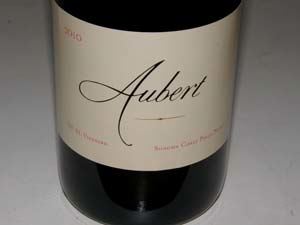 2010 Aubert UV-SL Vineyard Sonoma Coast Pinot Noir 15.0% alc., $80. · Moderately dark reddish-purple color in the glass. Aromas of smoky oak, tea leaf, oil and faint black fruit jam. Oak-infused flavors of dark berries, plum and cassis. Meaty with plenty of dry tannin, finishing juicy with good acidity. A man’s Pinot with full-on extraction displaying more oak at presence than I prefer. Wellcrafted in its style. Good.
Known for certified-sustainable, organically grown and Biodynamic® wines, Benziger Family Winery became the first Demeter-certified Biodynamic® vineyard in Sonoma County in 2000. The 25-acre Sonoma Coast de Coelo (day-chay-low) Estate (22 acres of vines) is a cool, windswept site, five miles from the Pacific Ocean, which is on the edge of where Pinot Noir can be grown successfully. De Coelo is divided into two distinctive blocks: Quintus and Terra Neuma. The vineyard team works overtime here to ensure that the vineyard capitalizes on every ray of sun.
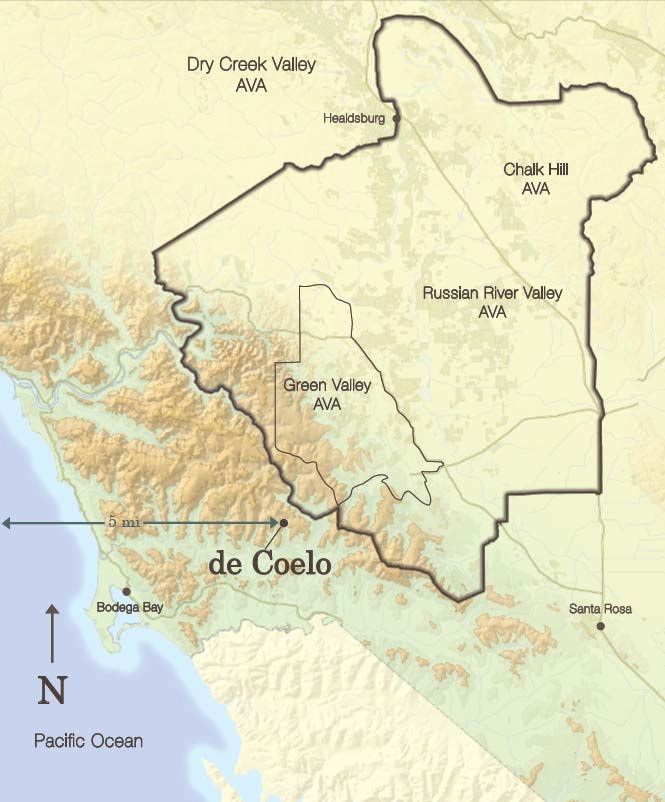
2010 Signaterra Bella Luna Vineyard Russian River Valley Pinot Noir 14.5% alc., pH 3.56, TA 0.62, 629 cases, $50. Released September 2012. Demeter Certified Biodynamic® vineyard. Dijon clones 115, 667 and 777. Yields 2.52 tons per acre. Native yeast fermentation and spontaneous malolactic fermentation. Aged 18 months in 35% new French oak barrels. Unfiltered. · Moderate reddish-purple color in the glass. Aromas of Bing cherries and espresso oak. Discretely concentrated core of dark cherry fruit with accents of clove, nutmeg and cola. Admirable restraint and appealingly delicate, with a lovely fruit core, but displaying too much of an oak topcoat at present. This wine will appeal to those who like plenty of oak with their Pinot Noir. Good.
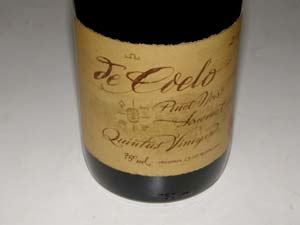 2010 de Coelo Quintus Vineyard Sonoma Coast Pinot Noir 13.0% alc., pH 3.48, TA 0.63, 177 cases, $75. From a Freestone-Occidental very cool site that is Demeter Certified Biodynamic®. “de Coelo” translates to “that which is of heaven.” Clones are 667, 777 and Swan. 25% whole cluster. Fermented with native yeast. Aged 16 months in French oak barrels. Unfiltered. · Moderately light reddish-purple color in the glass. Alluring scents of earth, dark red cherries and berries, spice and oak. This wine tastes of the soil as well as dark cherry and red plum flavors, complimented by oak, finishing with refreshing acidity and a flourish of cherry. A lighter weight vintage for this wine. Better the following day from a previously opened and re-corked bottle indicating cellaring is advisable. Very good.
2010 de Coelo Tierra Neuma Vineyard Sonoma Coast Pinot Noir 14.1% alc., pH 3.48, TA 0.63, 177 cases, $75. Demeter Certified Biodynamic® vineyard. 25% whole clusters. Fermented with natural yeast, unfiltered. · Medium reddish-purple color in the glass. Aromas of oak-infused cherries, espresso and Christmas spices. Driven by fresh and uplifting acidity, this wine features dark red fruits that have an earthy underpinning. A little more body, tannins and finish than Quintus, with more oak topcoat. More appealing the following day from a previously opened and re-corked bottle. Very good.
The wines in this vintage have daunting tannins and I found it very difficult to get my arms around them. This is one of the least approachable vintages for Calera in recent memory. It should take years for them to soften and recant, and although there is enough fruit to stay the course, the wines will always be tannic. I found it challenging to pick out vineyard terroir at this stage, only finding Reed distinctive. These are definitely not wines for drinking tonight, even with decanting. I found them impenetrable the following day as well from previously opened and re-corked bottles.
2009 Calera de Villiers Vineyard Mt. Harlan Pinot Noir 14.4% alc., 1,460 cases, $35. 15.6-acre vineyard, yields 2.06 tons per acre. Made from organic grapes. Native fermentations, aged 16 months in 30% new French oak barrels. Unfiltered. · Medium reddish-purple color in the glass. Aromas of ripe plum, blackberry and raisin with hints of damp earth and oak. Moderately rich array of very ripe purple and black fruits with a hint of Hoison sauce and Asian spice, backed by modest tannins. The most approachable wine in the 2009 lineup. Good.
2009 Calera Ryan Vineyard Mt. Harlan Pinot Noir 14.1% alc., 2,318 cases, $40. 13.7-acre vineyard, yields 2.33 tons per acre, aged 18 months in 30% new French oak barrels. Unfiltered. · Moderately light reddish-purple color in the glass. Shy aromas and flavors of dark cherries and raspberries. The appealing fruit is buried in overwhelming tannins. Good.
2009 Calera Reed Vineyard Mt. Harlan Pinot Noir 14.8% alc., 281 cases, $52. 4.4-acre vineyard, yields 1.02 tons per acre. Aged 17 months in 30% new French oak barrels. Unfiltered. · Light reddish color in the glass. Enticing aromas of strawberries, red cherries and sandalwood. More vineyard terroir evident that the other vineyard-designated Pinots in this vintage. Flavorful core of cherries, brown spice and a hint of vanilla wrapped in balanced tannins. Not the fruit intensity of the other Pinots in this vintage, but the long aromatic finish leaves an enticing trail of cherries. A feminine wine in a dominatrix way. Very good.
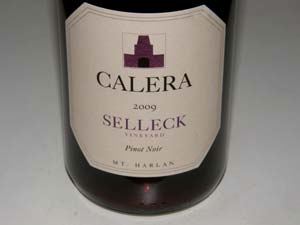 2009 Calera Selleck Vineyard Mt. Harlan Pinot Noir 14.1% alc., 420 cases, $78. 4.8-acre vineyard, yields 1.21 tons per acre. Aged 17 months in 30% new French oak barrels. Unfiltered. · Moderately light reddish-purple color in the glass. Nicely scented with aromas of blueberries, blackberries and clay. Fat in the mouth with generous flavors of black cherries, blueberries and boysenberries backed by muscular, firm tannins. The wine has an extra depth of flavor at the end just when you think it is finished. Very good.
2009 Calera Mills Vineyard Mt. Harlan Pinot Noir 14.9% alc., 1,599 cases, $45. 16.3-acre vineyard, yields 1.55 tons per acre. Aged 18 months in 30% new French oak barrels. Unfiltered. · Light reddish-purple color in the glass. Muted aromas of dark red cherries and berries and oak spice. Generous fruit intensity starring black cherries, finishing with good fruit presence. Very muscular tannins currently overwhelm the fruit. Good.
2009 Calera Jensen Vineyard Mt. Harlan Pinot Noir 14.5% alc., 1,277 cases, $73. 13.5-acre vineyard, yields 1.34 tons per acre. Aged 17 months in 30% new French oak barrels. Unfiltered. · Moderately light reddish-purple hue in the glass. Restrained aromas of darker berries and subtle oak. Very pretty core of discretely concentrated black cherry fruit buried in flamboyant tannins. A captivatingly long finish exceeds that of any other Calera Pinot in this vintage. The future looks very bright but this wine will demand patience. Very good.
This winery has had a long and successful journey that began with the purchase of 321 acres in the northern true Sonoma Coast in Cazadero in 1990 by Walt and Joan Flowers. The site was named Camp Meeting Ridge after the Pomo Indians who camped in the area in the summer. A gravity-flow winery was added in 1997, and an additional 327 acres, named Flowers Ranch, was added the same year. Today, neighboring vineyards include Hirsch, Marcassin, Hellenthal, Blue Slide Ridge, Failla and Pahlmeyer. There have been a number of talented winemakers at Flowers who have gone to distinguish themselves at other wineries. Since 2008, the winemaker has been Darrin Low. The viticulturist, Larry Bradley, has been at Flowers since the early 1990s. Production is about 27,000 cases a year of Pinot Noir and Chardonnay, 85% of which is estate grown. In 2009, Huneeus Vintners bought substantial interest in Flowers and Walt and Joan Flowers retired from their project. The 2010 vintage saw the inaugural production of block-designated Pinot Noirs.
2010 Flowers Camp Meeting Ridge Estate Vineyard Sonoma Coast Pinot Noir 14.0% alc., $70. Calera, Swan, Dijon, Wädenswil and Pommard clones. Schist, shale and sandstone soils. 1200 to 1400 feet elevation. Yields 1.89 tons per acre. 100% de-stemmed. Aged 16 months in 57% new French oak barrels. · Medium reddish-purple color in the glass. Clean aromas of black cherries, black raspberries, dark strawberries, clove spice and smoky oak. The flavors replicate the aromas in a middleweight offering that has balanced tannins, and an appealingly soft and smooth mouth feel. Picks up interest over time in the glass. Good (+).
2010 Flowers Sea Ridge Estate Vineyard Sonoma Coast Pinot Noir 14.0% alc., $65. Heritage, 777, 825 and 115 clones planted in schist, shale, basalt and sandstone soil. 1400 to 1800 feet elevation. Yields 1.91 tons per acre. 5% whole cluster. Aged 16 months in 40% new French oak barrels. · Moderately light reddishpurple color in the glass. Shy aromas of raspberries and cranberries with a hint of briar. Dark red fruits are featured in a modest weight wine with balanced tannins, a sleek, smooth texture, and some generous fruit length on the finish. Very nicely crafted and rather sophisticated. Very good.
2010 Camp Meeting Ridge Estate Vineyard Block 11 Sonoma Coast Pinot Noir 14.0% alc., $75. 1.16- acre block at 1400 feet elevation. Schist and shale soil. Calera selection. Yields 2.21 tons per acre. Aged 17 months in 40% new French oak barrels. · Moderately light reddish-purple color in the glass. Muted aromas of darker red berries. A solid offering with well-ripened dark red raspberry and cherry flavors, elevated by good acidity and framed by ripe tannins. Nothing really stands out, but drinks nicely. Should benefit from more time in the cellar. Good.
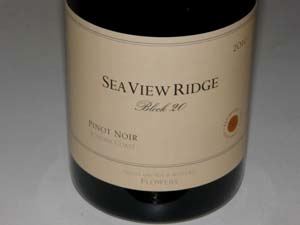 2010 Flowers Sea View Ridge Estate Vineyard Block 20 Sonoma Coast Pinot Noir 14.0% alc., $75. 1.55-acre block at 1700 feet elevation. Shallow volcanic clay loam over basalt, schist and shale soil. Clone 777. Yields 2.38 tons per acre. Aged 17 months in 40% new French oak barrels. · Moderately light reddish-purple hue in the glass. Penetrating, enthralling aromas of perfectly ripe black cherries and black raspberries. Luscious flavors of black cherry cola, griottes kirsch, and dark berries, modest dry tannins, bright acidity and a velvety mouth feel. I like this for its balance, texture and fruit persistence on the finish. A regal wine.
2010 Flowers Sea View Ridge Estate Vineyard Block 21 Sonoma Coast Pinot Noir 13.9% alc., $75. 1.15- acre block at 1400 feet elevation. Shallow clay loam over sandstone soil. Clone 777 and Swan selection. Yields 2.15 tons per acre. Aged 17 months in 16% new French oak barrels. · Light reddish color in the glass. Intense aromas of cherries. The lightest and most red-fruited of the Flowers Pinot Noirs in this vintage. Wellnuanced flavors of cherry hard candy, Asian 5-spice and pine tar. Beautifully crafted with gentle tannins and vivid underlying acidity. Has a unique chalky undertone. Very good.
A small producer of Pinot Noir, Zinfandel, Syrah and Chardonnay launched in 2009. The estate Vineyard is on Sonoma Mountain situated at 900 feet directly above Gap's Crown Vineyard in the Sonoma Coast AVA. The property sits above the fog line, allowing additional exposure to the sun throughout the growing season. Temperature inversion results in warmer nights and cooler days than vineyards at lower elevations. This allows fruit to ripen while lessening the need to leave the fruit hanging for extended periods. Being above the fog line, also helps keep fungus and mold at bay. The winery is a partnership between Brent Bessire and Evan Pontoriero. Brent learned the wine business from Gary Farrell and time spent at Mauritson Family Winery. Evan has had a successful career in film, but devoted his spare time to learning about wine, eventually becoming a hobby winemaker. He developed a friendship with Brent after the two met at a number of wine events. The first vines were planted on Sonoma Mountain in 2007 and the winery’s first wine was produced in 2009 from purchased grapes. The wines are available direct and from fine dining establishments in California.
2010 Fogline Vineyards Sonoma Coast Pinot Noir 13.7% alc., pH 3.35, TA 0.67, 80 cases, $42. Released fall 2011. Sourced from the Sun Chase Vineyard on the western slope of Sonoma Mountain at 1200 to 1400 feet elevation in the Petaluma Gap. Clones 667 and 777. · Moderately dark reddish-purple color in the glass. Complex nose offering many scents that come and go including black cherries, plum sauce, strawberries, pipe smoke, dark chocolate, herbs, dusty earth and a floral note. Middleweight cherry-driven flavor with a hint of spice, dried herbs, tobacco and even peach. Elegant, with soft tannins and respectable acidity, finishing with a citrusy cherry flavor. An interesting chameleon of a wine, but a bit strange in its combination of aromas and flavors. Good.
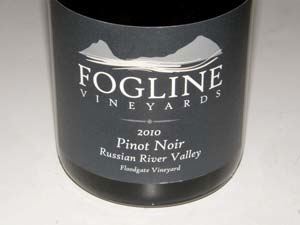 2010 Fogline Vineyards Floodgate Vineyard Russian River Valley Pinot Noir 14.5% alc., pH 3.40, TA 0.65, 135 cases, $38. Vineyard is located in Middle Reach of Russian River Valley. Clones 115, 666, 777 and Pommard. · Medium reddish-purple color in the glass. Smooth, spicy and sexy, with seductive aromas of dusty, dark cherries, graham and toast. A cherry bombast that is luscious yet refined and silky with complimentary hints of spice and cola. Nicely balanced with supple tannins and good staying power on the finish. The pedigree of this established vineyard shows through. A high-collared, impressive offering.
The wines in the 2009 vintage were crafted by former Gary Farrell winemaker Susan Reed. She was trained by Gary Farrell when he was still consulting at the winery and her style reflects his. All three of these wines are sourced from top notch vineyards.
2009 Gary Farrell Stiling Vineyard Russian River Valley Pinot Noir 14.2% alc., pH 3.42, TA 0.65, 287 cases, $50. Vineyard owners, Don (now deceased) and Barbara Stiling converted a 48-acre apple ranch to vineyards in 1988. The site has well-drained Goldridge soils. Field selection of Swan clone. · Light reddishpurple color in the glass. Shy scent of red cherries, red berries, candy jar and herbs. Elegant array of red fruits with a slight confected bent, finishing with lengthy flavors of cherry cola and herbs. The tannins are restrained and a very soft mouth feel adds to the appeal. I liked it more over time in the glass. Very good.
2009 Gary Farrell Hallberg Vineyard Dijon Clones Russian River Valley Pinot Noir 14.1% alc., pH 3.42, TA 0.67, 307 cases, $60. Released February 1, 2012. 100-acre vineyard named for its previous owners, Don and Marcia Hallberg. Now meticulously farmed by owner Kirk Lokka, a Sonoma-Cutrer alumnus. Dijon clones. · Moderate reddish-purple hue in the glass. Shy, but pleasant aromas of dark red and black cherries and berries, picking up more intensity over time in the glass. Very soft and silky in the mouth, with flavors of earthkissed dark red and purple fruits, finishing with exuberant cherries and raspberries and a good cut of acidity. Not fully expressive now, but still leaves a nice impression. Very good.
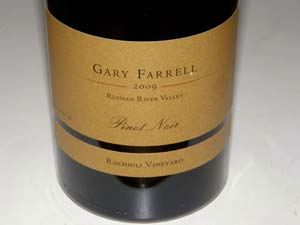 2009 Gary Farrell Rochioli Vineyard Russian River Valley Pinot Noir 14.0% alc., pH 3.48, TA 0.61, 406 cases, $65. Released November 1, 2011. Sourced from blocks planted in 1974, 1995 and 2000. Some of the fruit came from cuttings taken from the original “mother” block planted in 1968. Pommard clone. · Moderately light reddish-purple color in the glass. Needs some swirling in the glass to open up. Attractive perfume of well-ripened black cherries and baking spice. Middleweight flavors of cherry cola, spice and subtle oak caressed by gossamer tannins, finishing with uplifting acidity. Beautifully crafted. Not very expressive now, but one senses this could become extraordinary with several years in the cellar. Always the best Pinot Noir in the Gary Farrell stable.
Located on the eastern shore of Cayuga Lake, Heart & Hands produces less than 1500 cases of Pinot Noir, Pinot Noir Blanc, Brut Rosé and Riesling. I got to know proprietor and winemaker Tom Higgins several years ago on a trip to the Finger Lakes. He had his first serious winemaking experience at Calera Wine Company, subsequently returning to New York to work for Thirsty Owl Wine Company and Atwater Estate Vineyards while preparing to launch Heart & Hands. In 2008, he and his spouse, Susan, completed their winery building and tasting room and his dreams of owning a winery came to fruition. Tom also provides winemaking and vineyard consulting services throughout the Finger Lakes. An estate vineyard is now producing and seven clones of Pinot Noir were harvested in 2012. The Finger Lakes region is a challenge to viticulturists and winemakers due to the very cool climate, but Tom has achieved remarkable success with Pinot Noir. All three vineyard-designated Pinot Noirs reviewed here are different and worthy of a vineyard designation. Visit www.heartandhandswine.com. I was curious about how Tom managed to pick at low Brix and yet vinify his Pinot Noirs with 100% whole cluster. Here was his response. “Lower alcohol by volume (ABV) seems to be the norm here. I am always confused by the relationship between Brix and ABV when I talk to colleagues at tech symposia and can only presume it has a great deal to do with the glucose to fructose relationship. We normally pick our Pinot Noir somewhere between 22º and 25º Brix and for us, this translates into a 12.5% to 13.2% ABV. In 2010, fruit came in between 23.6º and 24.4º Brix. After we get above 20º, I toss out the refractometer and just go on the taste of the fruit and the numbers on the acidity. Also, I am looking for anywhere from 1” to 2” of lignification on the stems as a sign that the vines are beginning to pull their juices downward and set themselves up for winter. We have always had the 100% whole cluster program in place (the Barrel Reserve is our best representation of the blend of the single vineyards within the whole cluster framework and the “standard” Pinot Noir is typically 50/50).” “Many of my colleagues here warned me of the vegetal sensations they had contended with in years past with their Pinot Noir program, but after my stint at Calera and sampling plenty of examples of whole cluster wines from the similar cool climate of Burgundy, I was hard headed about what I believed could be done in the Finger Lakes. Ironically, I heard that more than 50% of the producers of Pinot Noir in the Finger Lakes in 2012 were going to be incorporating some level of stem inclusion in their Pinot Noir programs.” “The vegetal sensations are noticeable earlier in the fermentation process, but once things start cooking (our fermentation temperatures are usually between 82 and 92 degrees), those flavors have a tendency to blow off. I believe the softer oak treatment (with Francois Frères barrels) also reduces the impact and does not have the doubling down effect of those greener type flavor compounds that I would have encountered had I gone with an American oak program.” “We have been working with the Cornell extension for a few yeas to better understand our stem program and how this and clones relates to color and tannin preservation. While the 2010 version has been published, the 2012 version is still in the process of being run in their labs and is much more extensive.”
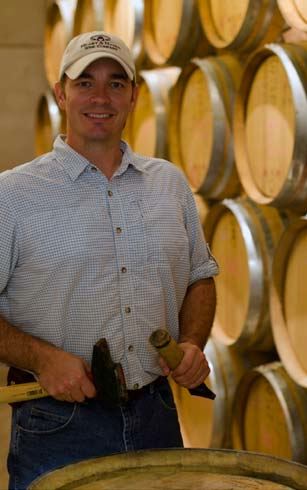
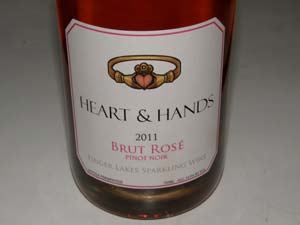 2011 Heart & Hands Brut Rosé Finger Lakes Sparkling Wine 12.5% alc., 115 cases, $25.99. Grown on shore of Seneca Lake. Whole cluster pressed and fermented in a stainless steel tank. · Pretty pink salmon color. Perfume of alpine strawberries and cranberries. Red fruited with imbedded citrus and minerality and slight alpine, herb note in the background. Slightly creamy with a healthy bead. Very crisp and completely dry. A satisfying offering.
2011 Heart & Hands Polarity Finger Lakes Pinot Noir Blanc 12.8% alc., pH 3.41, TA 0.62, 101 cases, $26.99, Vino-Loc closure. Whole cluster pressed Pinot Noir with limited skin contact. Barrel fermented with gentle lees stirring. Aged 9 months in French oak. · Faint honey, apricot color in the glass. Aromas of baked pear, grilled peach and blonde caramel. Unusual and challenging to taste with flavors of white stone fruits, toffee, and vanilla. Relatively light on its feet with a good cut of acidity on the dry finish. Good.
2011 Heart & Hands Elaine’s Vineyard Finger Lakes Pinot Noir 13.4% alc., pH 3.86, TA 0.67, 24 cases, $30.99, Vino-Lok closure Vineyard is a tribute to Elaine Hazlitt, a pioneer in the Finger Lakes wine industry. Located on the shores of Seneca Lake. Vineyard manager is John Santos. Yields 2.4 tons per acre. 100% whole cluster. Aged in Francois Frères French oak barrels. Unfiltered. · Moderately light garnet color in the glass. Nicely perfumed with scents of deep red berries, black cherries and a hint of stem. Moderately light in weight but flavorful featuring dark cherries and cranberries. Elegant with mild dry tannins and some length on the finish. Whole cluster is evident but in a good, non-vegetal way. Very good.
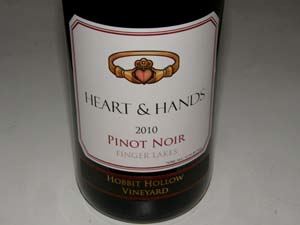 2011 Heart & Hands Hobbit Hollow Vineyard Finger Lakes Pinot Noir 12.1% alc., pH 3.79, TA 0.65, 24 cases, $30.99, Vino-Lok closure. Vineyard is located on the shores of the western side of Skaneateles Lake. Owner is Mike Falcone and vineyard manager is Paul Wellington. Yields 1.4 tons per acre. 100% whole cluster. Aged in Francois Frères French oak barrels. Unfiltered. · Light reddish-purple color in the glass. An intriguing wine offering aromas of cherries, creme soda, vanilla, and sandalwood. Light and elegant with flavors of fresh cherries, oak vanillin, spice and bacon. Gentle, dry tannins and bright acidity make for easy drinking. Still holding nicely two days later from a previously opened and recorked bottle. Very good.
2011 Heart & Hands Patrician Verona Vineyard Finger Lakes Pinot Noir 12.7% alc., 24 cases, $30.99, Vino-Lok closure. Vineyard is located on the western side of Cayuga Lake. Vineyard manager is Cameron Hosmer. Yields 2.3 tons per acre. 100% whole cluster. Aged in Francois Frères French oak barrels. Unfiltered. · Light garnet color in the glass. Aromas of darker cherry pie filling, compost, and leather. Tasty array of cherry, raspberry and spice flavors on a light, elegant base. Fresh, juicy and round with some length on the finish. A little mushroom and green garden is noted in the background. Good
The vineyard sources change from year to year for this Livermore, California producer, but the wines have been consistently excellent. Founded by Steven Kent Mirassou, who acquired the label from the family in 2005, the winery focuses on small lots of Pinot Noir sourced from multiple appellations in California and Oregon. The winemaker, Tom Stutz, has a master’s degree in viticulture from University of California at Davis. His Pinot Noir winemaking experience has included time at Domaine Chandon in Napa Valley, Hanzell Vineyards in Sonoma County and Mirassou Vineyards in San Jose. Some wines are sold exclusively to members of the winery’s Pinot Noir Program. Visit www.lrwine.com for information. The wines are produced as follows. After de-stemming and crushing, the fruit is fermented in 1.5-ton open-top fermenters. Primary and malolactic fermentation are induced. Aging is carried out for an extended time in 100% French oak.

2009 La Rochelle Russian River Valley Pinot Noir 14.1% alc., 55 cases, $42. Released August 3, 2012. 100% Pommard clone grown on the Dutton’s Campbell Ranch with a small amount of Mission Ranch Swan selection blended in. Aged 17 months in 100% second used French oak barrels. · Moderate reddish-purple color in the glass. Nicely perfumed with aromas of fresh picked black cherries, black raspberries, rose petals and spice. Deep, but not overbearing flavors of Bing cherries and cola, caressed by soft tannins, infused with vim by bright acidity, and offering a lengthy memory of cherries on the finish. Quintessential Russian River Valley Pinot Noir and one of the better appellation wines from that region on the market. Very good (+).
2009 La Rochelle Conzelman Vineyard Anderson Valley Pinot Noir 14.6% alc., 115 cases, $48. Released July 14, 2012. Clones 115 and 777. Aged 28 months in 60% new, 20% second use and 20% American oak. · Medium reddish-purple color in the glass. Savory nose with aromas of forest floor, stem and cherry with a touch of chemical peeking out. Slightly confected cherry flavor with an underlying savory herb riff. Moderately light in weight with mild sandy tannins, finishing very dry and herbal. Decent.
2009 La Rochelle Dutton Ranch Campbell Vineyard Russian River Valley Pinot Noir 14.2% alc., $48. Released January 14, 2012. Farmed by the Dutton family, this vineyard is located near the towns of Graton and Occidental. 100% Pommard clone. Aged 16 months in 50% new French oak barrels. · Medium reddishpurple hue in the glass. Really enticing nose that picks up considerable olfactory interest over time in the glass. Aromas of dark cherry pie glaze, dark berries and spice. Plenty to like with nicely ripened flavors of dark red cherries and berries, nicely spiced, picking up intensity over time. A spirited wine with supple tannins, really struting its stuff the next day from a previously opened and re-corked bottle. Very good.
 2009 La Rochelle Donum Estate Vineyard Carneros Pinot Noir 14.6% alc., 115 cases, $75. Released October 1, 2012. Inaugural release from this vineyard. 100% Donum clone (a massal selection from cuttings brought to California by Roederer). Aged 19 months in 40% new and 60% second use French oak barrels. · Moderate reddishpurple color in the glass. A very exotic wine exhibiting aromas of wild berries and musk that really draws you into the glass. Delicious array of dark red and black berries with a touch of spice and an earthiness which adds to the appeal. Very supply fine-grain tannins, a silky texture and generous finishing power. Significantly better the following day from a previously opened and re-corked bottle. Like actress Keira Knightley, perfumed and sensuous.
 2009 La Rochelle Tondre Grapefield Santa Lucia Highlands Pinot Noir 14.8% alc., 125 cases, $48. Released September 8, 2012. Originally planted to 6 acres of Pinot Noir in 1997. Today the vineyard contains 80 acres of Pinot Noir and 25 acres of Chardonnay, farmed by Joe Allarid. Clones 943 and Pommard are in this bottling. Inaugural release from this vineyard. Aged for 18 months in 20% new and 80% second use French oak barrels. · Medium reddish-purple color in the glass. Smells like the freshest blackberry jam you have ever experienced. Delicious and entirely seductive, with a moderately intense core of blackberry, cassis, Hoison sauce and vanilla flavors. Smooth and satiny, with well-balanced tannins, well-integrated acidity in the background and the most outrageously long finish of all the wines in this La Rochelle lineup. I have had several great wines from this vineyard and this one continues the trend.
2009 La Rochelle Sleepy Hollow Vineyard Block A Santa Lucia Highlands Pinot Noir 14.7% alc., 275 cases, $48. Released August 2, 2012. Martini and 113 clones. Aged 26 months in 45% new and 55% second use French oak barrels. · Moderate reddish-purple hue in the glass. Smells like a smoke-tainted wine with strong aromas of wood smoke and tar. Unpleasant ash, smoke and tar flavors overwhelm the middleweight dark fruit core which is presented on a silky platform with supple tannins. Unsatisfactory, but I only had one bottle to review and this wine was definitely not consistent with the many wines I have had from this winery.
2010 Pisoni Estate Santa Lucia Highlands Chardonnay 14.2% alc., $65. Unfiltered. · Light straw color with a faint haze in the glass. Lovely aromas of pear, lemon and lychee. Dry with spritely acidity, featuring flavors of lemon, baked pear, lychee, brown butter and dark caramel. Appealing restraint. Very good.
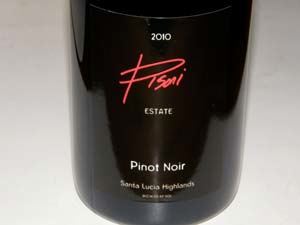 2010 Pisoni Estate Santa Lucia Highlands Pinot Noir 14.3% alc., 580 cases, $55. Unfiltered. · Deep, dark purple color in the glass. Scent of dark berry preserves with a complimentary hint of smoky oak and vanillin. Delicious core of vibrant blackberry and black plum flavors with undertones of smoke, tar, vanilla, and earth. Full-bodied with masculine tannins, yet soft and quite approachable now. Offers grip, breed and length. A man’s Pinot that never disappoints and one of California’s most cherished iconic wines year in and year out.
These wines are from the 15-acre Schultze Family Vineyard located in Corralitos in the Santa Cruz Mountains AVA at 900 feet above Monterey Bay. The vineyard is farmed and the wines are vinified on site by the Schultze family. Since their beginnings in 1999, the winery has been a consistent performer with dedication to every detail of production: 100% gravity during harvest, crush, press and bottling. About half of the fermentation bins are done with indigenous yeast. All wines are unfiltered and unfined. The winery’s website has been updated and is now very informative (www.windyoaksestate.com).
2009 Windy Oaks Estate Proprietor’s Reserve Schultze Family Vineyard Santa Cruz Mountains Pinot Noir 13.9% alc., $60. Signature wine primarily from the 1.5-acre Bay Block of the original 3-acre vineyard. Unfined and unfiltered. Available only to Windy Oaks Wine Group members and at the tasting room. · Moderately light reddish-purple color in the glass. Lovely perfume of fresh cherry pie filling, baking spices, compost and sandalwood. Light and elegant, gentle and calming, this wine offers flavors of red cherries, strawberries and spice balanced with ripe tannins and lively acidity. The cherry flavor holds on tight on the long finish. A little lighter in this vintage and needs more time in the cellar for the tannins to recede. Very good.
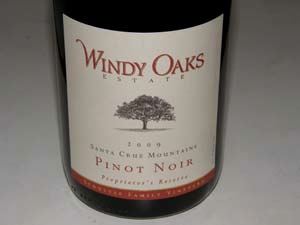 13.9% alc., $55. Fermented up to 8 weeks in 1-ton, open fermentation French oak tanks. · Medium garnet color in the glass. This wine has the type of nose that drives pinotphiles crazy. Effusive aromas of dark red cherries and berries, dark red rose petals and spice. Moderately rich dark red cherry and raspberry fruits accented with caramelized oak and spice. The tannins are a little more aggressive in this wine but they are not obtrusive and will moderate with time. I like this charming wine for its additional complimentary oak contributions including the exotic spice that marries with Pinot fruit so well. Rare to find an oak tank fermented Pinot Noir in California since it is more challenging to successfully vinify.
13.9% alc., $55. Available only to Windy Oaks Wine Group members and at the tasting room. · Medium reddish-purple color in the glass. Brooding aromas of deep red cherries, dark berries, spice and oak vanillin. Middleweight flavors of darker red stone fruits and berries with a savory undertone. Soft and elegant with respectable length, showing firm tannins and a hint of stem. A little more open and appealing the following day from a previously opened and re-corked bottle. Not as good as the bottle of this wine I reviewed earlier in the year. Good (+).
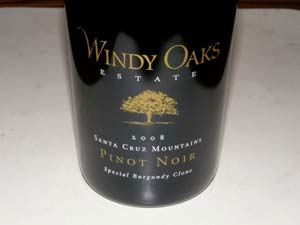 14.3% alc., $75. Very limited. From a special half-acre section of the vineyard that is carefully hand-tended exclusively by Jim Schultze. The clone is a rarely propagated French Pinot Noir clone not available in the United States. Aged 27 months in 100% new French oak. Unfined and unfiltered. · Moderate reddish-purple color in the glass. A very polished and sophisticated offering that reminds me of a Frédéric Mugnier wine from Chambolle-Musigny. Deep cherry and spice aromas and flavors that take on an extraordinary appeal over extended time, seemingly partnering with the glass. Comforting and silky with soft tannins and beautifully integrated oak. Very food friendly (try roast chicken). My wife was impressed and that is saying something. Still great the next day when we finished the bottle. Truly in a class by itself.
A small family winery run by partners James McDonough and his father, James McDonough, Sr.. The winemaker is Russell Bevan and Chris Walden of Hambrecht Vineyard Management is the vineyard manager and Virginia Lambrix is the viticulturist. Very appealing website and wine labels offering a first-class impression. The 2009 vintage wines were highly rated by the Wine Advocate. I found the wines in this vintage to be very bold expressions of Pinot Noir, rich and dense with very ripe fruit, and plenty of oak detailing. They may not be to my preference stylistically, but it is tough to argue dogma. It’s a little like complaining of a lover that he or she is too beautiful.
2010 Wren Hop Vineyards Stolen Crown Russian River Valley Pinot Noir 14.6% alc., pH 3.73, 75 cases, $62. Clones 667, 777 and 115. Aged 14 months in 100% new French oak barrels. · Dark reddish-purple color in the glass. Aromas of black grape juice, blackberry jam, cooked fruit and oak. Full-bodied, rich and dense with dark berry fruit, prodigious tannins including some oak tannins, notes of oak-driven dark caramel and anise in the background, finishing with a bit of heat. Decent.
2010 Wren Hop Vineyards Shriveled Hand Sonoma Coast Pinot Noir 14.8% alc., pH 3.95, 50 cases, $62. Grapes sourced from Sun Chase Vineyard in the Petaluma Gap. Clone 777. Aged 14 months in 100% new French oak barrels. · Dark purple color in the glass. Aromas of dark mocha java with little fruit evident. Bigboned, with generous amounts of coffee-scented, sweet black cherry fruit wrapped in firm tannins. Promising fruit core which is buried in oak at present. Give this wine time in the cellar. Good.
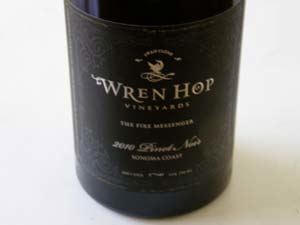 2010 Wren Hop Vineyards The Fire Messenger Sonoma Coast Pinot Noir 14.6% alc., pH 3.80, 100 cases, $62. Grapes sourced from Wren Hop and Gap’s Crown vineyards. Swan clone. Aged 11 months in 100% new French oak barrels. · Moderate reddish-purple color in the glass. Appealing scents of black cherries, black raspberries and spice. A full mouth of luxurious black fruits with accents of cola and dark chocolate. This wine displays much better acidity and good integration of oak, and has a very seductive soft, velvety mouth feel. Very good for its style.
Grocery Store PinotLeading up to Thanksgiving this year, the major local grocery store chains in Orange County, California promoted wine by prominent floor displays and discounts. Preferred grocery store card holders received a modest reduction in price, but a further discount of 30% was offered with six bottle mix and match purchases. One store had a limited offering of 30% off any bottle with an additional 10% off for six bottle buys. The participating markets included Albertson’s, Ralph’s (The Kroger Company) and Vons & Pavilions (Safeway Inc.). All these chains have a national presence, and possibly this discount program was also offered in other parts of California and in other states. The Pinot Noir wines lining the shelves at these stores is practically identical at each store, controlled by the largest wine company in the world, E. & J. Gallo Winery, the second largest, The Wine Group, and the third largest, Constellation Brands. Gallo’s brands featuring Pinot Noir include Barefoot Cellars, Bridlewood, Edna Valley Vineyards, Frei Brothers, and MacMurray Ranch, and very inexpensive Pinot Noir labels such as Mirassou, The Naked Grape, Wild Vines and Turning Leaf. The Wine Group Pinot Noir labels include Brophy Clark, Concannon Vineyard, Cupcake Vineyards, and Pinot Evil. Constellation Brands include Estancia, Mark West, Robert Mondavi Winery, Simi and Wild Horse. These companies have a firm grip on the shelf space at these grocery chains. Kendall-Jackson Wine Estates has a somewhat less, but still prominent presence, with the Byron, Cambria, Carmel Road, Kendall-Jackson and La Crema brands of Pinot Noir. There are no small, boutique producers of California or Oregon Pinot Noir available on these grocery store shelves. The top three wine producers, Gallo, The Wine Group and Constellation, account for 64% and 63% of all wine shipped in California in 2011 and 2010 respectively (Gomberg Fredrikson 2011 Annual Wine Industry Review). Many of their wines are very inexpensive, and according to Wines & Vines (January 2012), more than 85% of all the wine sold in the United States costs $9 or less per bottle. Only large growers are able to produce this amount of wine at this price point and still be profitable. Annual United States sales case volume for Gallo was 80 million in 2011. Most grocery store wine departments have a four or five shelf tier with the highest quality and most expensive wines occupying the top shelf, and the most inexpensive wines relegated to the bottom shelf. Since there is a high turnover, vintages are current for the most part. Only a few Pinot Noir wines are priced above $20, with the majority in the $10 to $20 and under $10 range. Practically all Pinot Noir offerings at the grocery markets in Orange County are from California except Erath, A to Z and Willamette Valley Vineyards Pinot Noir, all of which have very large case production and widespread distributing power.
 I acquired 28 representative bottles of Pinot Noir from the three supermarket chains who were offering discount programs and tasted them blind together with my Grape Radio wino colleagues, Eric Anderson and Jay Selman. The wines were fresh from the stores, and tasted immediately after opening in order the replicate the consumer’s experience (most consumers bring home wine after grocery shopping and drink it within a day or two). Nearly all wines were from the 2010 vintage, with a few from the 2011 vintage which in California and Oregon offered a very similar cool growing season. Prices listed are the discounted price at check out. I did not include any of the high-end brands found on some top shelves such as, J Vineyards, Laetitia, Sonoma Cutrer, and Twomey, all of which are well-established, quality brands. I concentrated on the under-$20 labels. This organized blind tasting removed all preconceived notions of wine price and reputation of the producers. In other words, we were looking for the best grocery store Pinot Noirs, regardless of price or label. Since all three of us are seasoned professional wine tasters, are standards are higher than those of the average consumer and this should be taken into account in interpreting the results. A note about the ranking system I used in the tasting. In Oregon Wine Press (October 2011), Oregon mathematician and avid wine collector Neal Hulkower wrote a commentary on methods of ranking wines in comparative tastings. He points out that having individuals score wines and adding up the results is flawed and does not represent the true preferences of the tasters. “Easy graders’ votes carry more weight in the tally than tougher ones, thereby violating the sacred principle of ‘one taster, one vote.’” Instead, Hulkower defends the Borda Count method, which has each taster rank order the wines and then use a preferential voting scheme to aggregate the rankings yielding what is called the societal outcome. If there are X wines being tasted, the first ranked bottle receives a score of X-1, the second X-2, and so on with the wine ranked last getting a score of 0. The scores for each wine are summed to determine the societal outcome. I used the Borda Count in determining the societal outcome of this tasting. My assistant who did the tabulations is pictured below.
 Information about the wines, when available, is provided. Wineries often divulge little production details about their value-priced wines. Wines that are known to be 100% Pinot Noir are so designated. Wines can still be labeled Pinot Noir as long as other varieties do not exceed 25 percent. On last caveat. Twenty years ago, many wine writers attributed the expense of Pinot Noir to the fact that it did not lend itself to large-scale winemaking, responding best when made in small batches. The demands of Pinot Noir winemaking were considered so challenging that the wine’s subtleties were easily lost in large production regimens. Michele Anna Jordan wrote in the Wine Enthusiast in 1999 the following. “Lucky for those of us intoxicated by the ephemeral wonder of a consummate Pinot Noir, the grape will never become the next big thing. It simply won’t cooperate on a grand enough scale.” Although today the greatest New World Pinot Noir wines are made in tiny quantities, the remarkable advances in large-scale Pinot Noir winemaking using selective manipulation have led to a plethora of good wines in the under $20 price category. There have been claims that these value-priced wines would ruin the lofty reputation of Pinot Noir, but au contraire, these wines are pretty darn good, they have made the grape more accessible to the general wine drinking population, and as a result, Pinot Noir has replaced Merlot and Zinfandel and challenged Cabernet as the go to red for most regular wine drinkers. The quality of a number of the wines in this tasting affirms the popularity of the under $20 price category on grocery market shelves. Pinot Noir sales are hot with most consumer purchases focused on wines in the under $20 category. Wines & Vines (December 2012) reports that the retail sales of domestic table wines priced between $11 and $19.99 has increased rapidly this year. According to Symphony IRI Group (SIG), wines from $11-$14.99 and $15- $19.99 grew at 10% and 12% respectively through October 7. These two segments accounted for 20% of the $3.7 billion spent at major U.S. food and drug stores. The general census on the wines in this tasting was as follows:
* All wines were much more similar than different.
The tasting notes below represent comments by all three judges. The winner (this wine was chosen as the best wine by all three judges!):
 The rest of the top 5: #2 2010 La Crema Monterey Pinot Noir $15.39 13.9% alc., pH 3.82, TA 0.52, mostly from estate vineyard in Arroyo Seco. 100% Pinot Noir. Aged 7 months in 98% French oak (21% new) and 2% American oak (1% new). Moderately dark reddish-purple color in the glass. Bright Bing cherries on the nose. Moderately rich dark red cherry and berry core, smooth texture, mild tannins, and decent finishing intensity. #3 2010 Kendall-Jackson Vintner’s Reserve California Pinot Noir $14.99 13.5% alc., 50,000 cases. 54% Santa Barbara County, 41% Monterey County and 5% Mendocino County - all Jackson Estates grown. Moderately deep reddish-purple color in the glass. Reserved aromas of dark cherries and red grape preserves with a hint of oak spice. Tasty core of dark cherries with a hint of spice. Nicely balanced with well-honed tannins, a smooth mouth feel, and nicely integrated acidity. #4 2010 Edna Valley Vineyard Paragon Edna Valley San Luis Obispo County Pinot Noir $9.99 13.9% alc.. Light reddish color in the glass. Pretty nose of toasty cherries. Thin and slightly tart, but with a tasty core of dark, dried red cherries and red berries, supple tannins, and complimentary oak. A solid, straightforward wine. #5 2010 Castle Rock Mendocino County $8.49 13.5% alc.. Medium reddish-purple color in the glass. Moderately rich core of ripe black cherries and black currants backed by firm but balanced tannins, finishing with good fruit intensity. Worth a look (good wines that offer good value) not in any particular order: 2010 667 (Noble Wines) Monterey Pinot Noir $9.99 14.5% alc., pH 3.60, TA 0.52. De-stemmed, 3-day cold soak, inoculated fermentations, pumped over, aged in French and American oak. Medium reddish-purple color in the glass. Shy but pleasant cherry fruit on the nose. Middleweight flavors of dark cherries and berries with good acidity in the background, mild tannins and an attractively smooth mouth feel. 2010 J. Lohr Estates Falcon’s Perch Monterey County Pinot Noir $10.15 13.5% alc. 100% Pinot Noir. Mainly Dijon clones. Matured in stainless steel with minimal fraction aged in French oak barrels. Moderate reddish-purple color. A richer style with well-oaked black cherry and black raspberry fruits, accented with spice. Will appeal to those who like a good deal of oak with their fruit. 2010 Acacia Carneros Pinot Noir $12.99 14.4% alc., 55,000 cases. 100% Pinot Noir. From the estate vineyard and Winery Lake Vineyard. Dark cherry and berry aromas and flavors are featured in this moderately rich, slightly earthy wine displaying a subtle hint of oak, a good tannic backbone, and an easy-going, soft texture. 2011 Pennywise (The Other Guys) California Pinot Noir $7.40 13.5% alc., 27,000 cases. 90% Pinot Noir, 6% Barbera, and 4% Sangiovese. Primarily from Merwin Vineyard in Clarksburg with contributions from Monterey, Santa Barbara, Lodi, Solano County and the Sierra Foothills. Moderately light reddish-purple color in the glass. Very appealing aromas of fresh red fruits, exotic spice, herbs and oak. Middleweight fruit that is very ripe with hints of raisin, Hoison sauce and spice. Tastes like other varietals have been added in as confirmed by the winery, but this does not detract. 2011 Irony Monterey County Pinot Noir $12.99 13.5% alc.. 90% Pinot Noir, 5% Petite Sirah, 5% Cabernet Sauvignon. Moderately light reddish-purple color in the glass. Nicely perfumed with ripe cherries and spice. Flavorful cherry core with coarse tannins, good length and a very appealing velvety mouth feel. 2010 Carmel Road Monterey Pinot Noir $14.99 13.5% alc. Sourced from Arroyo Seco AVA. Multiple clones. Aged 8 months in 97% French oak (20% new) and 2% American oak (1% new) and 1% in stainless steel tanks. Moderate reddish-purple color in the glass. Shy aromas of cherries and sandalwood. Decent cherry cola flavor with cherries carrying over on the finish. Mild tannins, easy to drink. 2011 Wild Horse Winery & Vineyards Central Coast Pinot Noir $15.70 13.50% alc.. 100% Pinot Noir. 3 to 4 day cold soak, fermented in small open-top and closed-top fermenters, open-tops punched down and closed-tops pumped over, aged 8 months in 100% French oak (20% new). Moderately light reddish-purple color in the glass. Intense aromas of ripe strawberries and cherries. Middleweight core of delicious dark red stone fruits and berries with impressive balance. Very polished and seamless and one of my favorites but not one of the favored wines by other tasters. 2011 Gnarly Head California Pinot Noir $7.99 13.5% alc.. From DFV Wines. Moderately light reddish-purple color in the glass. Very shy nose that offers delicate cherry fruit over time. The flavors trump the nose in this wine which has a nice mid palate presence of bright cherry fruit, and a refreshing finish offering bright acidity. 2010 Bogle Vineyards California Pinot Noir $10.99 13.5% alc., 27,000 cases. From vineyards in the Russian River Valley, Monterey and Clarksburg. Aged 10 months in French and American oak. Moderately light reddish-purple color in the glass. Reticent aromas of strawberries and cranberries. Very fruity but not sweet with flavors of fresh strawberries, cranberries and raspberries. Very soft tannins and light on its feet. 2010 Rodney Strong Vineyards Russian River Valley Pinot Noir $13.29 14.5% alc. Aged 11 months in 100% French oak. Moderately light reddish color in the glass. Nicely perfumed with aromas of Bing cherries and sandalwood. Medium-weight flavors of oak kissed black cherries wrapped in cozy tannins. Pleasant and easy to drink. 2010 Mark West California Pinot Noir $6.99 13.8% alc.. Primarily Central Coast fruit. Fermented in small lots with daily punch downs, aged in French and Hungarian oak barrels for 8 months. Subtle aromas of Bing cherries and smoky oak. Flavorful core of cherries with some finishing length. Well-balanced tannins. A consistently good value wine although this vintage was not up to the quality of recent vintages. Other wines tasted and not particularly notable: 2010 Estancia Pinnacles Ranches Monterey County Pinot Noir $8.99 Thin, hollow, soft. 2010 MacMurray Ranch Central Coast Pinot Noir $13.99 Cloying, Jolly Rancher candy, plain. 2010 Byron Santa Maria Valley Pinot Noir $17.49 Darker fruited, sweet, soft. 2010 Erath Oregon Pinot Noir $13.29 Thin, tart, acidic, dilute, very light red fruits, and little herbal. 2010 Jargon California Pinot Noir $7.69 Smoky, tarry, slightly confected, grape juice flavor, ? other varieties. 2010 Aquinas Don Sebastiani & Sons Napa Valley Pinot Noir $14.99 Light cherry, chemical, plastic, disagreeable. 2010 Magistrate Sonoma Coast Pinot Noir $9.99, 4,000 cases. Very thin red fruits, high acid, herbal oak, unpleasant. 2010 Chateau St. Jean California Pinot Noir $8.87 Dark cherry, black raspberry, firm tannins, some finishing intensity. Tasters felt it wasn’t varietally correct and may have had other varieties included. 2010 Sebastiani Sonoma Coast Pinot Noir $14.99 Shallow mid palate, dark red and black fruits, softly textured, oak-driven nose. 2010 Francis Coppola Director’s Cut Sonoma Coast Pinot Noir $19.99 Very oak-driven with strong coffee grounds aromas and flavors suffocating the deep red fruit core. Aged 18 months in 50% new and 50% 1 to 2-year-old oak barrels. 2010 Frei Brothers Reserve Russian River Valley Pinot Noir $16.79 Very shy nose with delicate fruit aromas. Pedestrian dark stone fruit flavors with coarse tannins. NV Barefoot Cellars California Pinot Noir $3.97, 700,000 cases. Aromas of stem, flowers, geranium. Very light cherry flavors with herbal note.
Pinot BriefsBurt Williams Receives Overdue Recognition in WSJ Jan McInerney published a tribute to Burt Williams in the December 1-2, 2012 issue of the Wall Street Journal titled, “How Burt Williams Became Pinot’s Patron Saint.” As he points out in the article, the last wine Burt made, the 2009 Morning Dew Ranch Anderson Valley Pinot Noir, is now available and may be ordered by contacting the winery at morningdewranch@gmail.com.
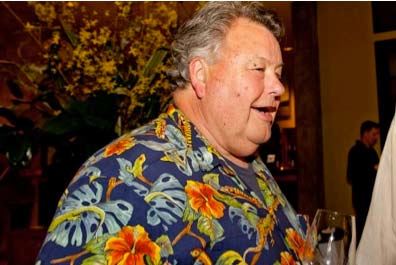 In Pursuit of Balance This event, which seeks to promote dialogue about the meaning and relevance of balance in California Pinot Noir and Chardonnay, will be held in San Francisco on February 4, 2013, and in Los Angeles on February 6, 2013. IPOB was created by Rajat Parr of Michael Mina and RN74 and Jasmine Hirsch of Hirsch Vineyards. The first event was held in San Francisco in 2011. A list of participating wineries includes a who’s who of California Pinot Noir. For the first time, the event’s seminars will be open to the public. A list of member wineries, a detailed schedule and tickets are available at www.inpursuitofbalance.com.
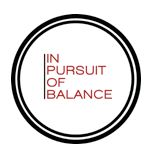 2013 Wines & Vines Directory & Buyer’s Guide Listings for all wineries in North America including profiles, information on suppliers, growers, custom crush facilities, and distributors. Available both in print and online for $95 at www.winesandvines.com. According to the 2013 Directory, there are 7,900 wineries in North America, 3,497 wineries in California, 11,100 winery brands, and 100 AVAs. “Holiday in the Hills” Members of the Sta. Rita Hills Winegrowers Alliance are hosting Open Houses and offering Sta. Rita Hills gift options. Visit the Alliance website at www.staritahills.com/events.html for a list of special member events. Freeman Vineyard & Winery New Website Ken and Akiko Freeman have updated their website to include many photographs and details about them and their wines, the vineyards they work with, and the experience they offer at their Sebastopol winery. As part of the unveiling, for the first time ever, they are offering magnums of four 2010 Pinot Noirs through their online store: 2010 Keefer Ranch, 2010 Russian River Valley, 2010 Sonoma Coast, and 2010 Akiko’s Cuvée. The wines are sold out in the standard size bottle format. Visit the website at www.freemanwinery.com. New Documentary on The Russian River Valley Winegrower Joe Nugent (who recently sold his vineyard in the Russian River Valley to The Donum Estate) has worked for years on a documentary that tells the story of the rise to prominence of the Russian River Valley through interviews with growers and winemakers. The film is titled, “From Obscurity to Excellence: The Story of Grapes and Wine in The Russian River Valley.” Key figures in the film include Joe Rochioli, Burt Williams, Mel Sanchietti, and Davis Bynum. The documentary was recently shown in Santa Rosa - look for more showings in the future (www.russian-river-valley.com).
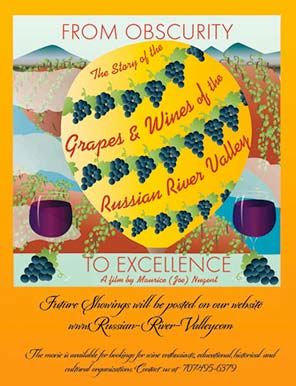 W.O.W. Comes to NYC Members of West Sonoma Coast Vintners are coming to New York City to host their first tasting outside of the annual West of West (W.O.W.) event held annually in Occidental, California. The West Sonoma Coast Vintners consists of 35 wineries including notable Pinot Noir producers such as Benovia, Freestone Vineyards, Littorai, Merry Edwards, Cobb, Flowers, Freeman, Papapietro-Perry, and Siduri. The date is Wednesday, February 27, 2013 at the City Winery. Tickets are $100 and can be purchased at www.citywinery.com/WOWNYC. The Eyrie Vineyards “Marguerite” Pinot Noir This 2000 vintage Pinot Noir was a gift from David Lett to his granddaughter, Marguerite Estelle Lett to commemorate her birth to her parents, Jason and Diane Lett. 2000 was one of David’s most esteemed vintages. He blended a favorite barrel selection from the 2000 vintage to make the “Marguerite,” which incorporates a little bit from each of The Eyrie vineyards. The front label displays a watercolor painting by Marguerite and the back label features the message, “A gift from her grandfather, from barrels selected in honor of the vintage of her birth. Love, Papa.” To purchase, contact Michael Alberty at Storyteller Wine Company in Portland (503-206-7029) or The Eyrie Vineyards website at www.eyrievineyards.com/, $85. Wine Consumption at a New Low in France The average French adult consumed about 15 gallons of wine in 2010 according to the French Ministry of Agriculture division FranceAgriMer. In 1965 the figure was about 42 gallons. In 2010, just 17% of the French had wine regularly. Speculation has it that the decline is due to more health awareness as well as the European debt crises and the unemployment rate of 10.7% in France. Foley Family Wines Buys Ramal East Vineyard The Ramal East Vineyard, about 206 acres of Pinot Noir and Chardonnay in Carneros, has been purchased by Foley Family Wines. The grapes will be used in the new Sonoma Coast tier of Chalk Hill Estate wines scheduled to debut in 2013. Wines owned by Foley Family Wines that currently produce Pinot Noir include Foley Estates (Sta. Rita Hills, CA), Lincourt Vineyards (Solvang, CA), Sebastiani (Sonoma County, CA), and Te Kairanga (Martinborough, NZ). Suckling’s “100 Points” Wine Glass The ultimate wine elitist gift this Christmas. Latimes.com (November 21, 2012) reported that the glass was designed in collaboration with American wine writer James Suckling and is offered by the 100-year-old glassblowing firm, Lalique. It is meant to be the ideal glass for both white and red wines as Suckling believes in one glass for every wine. A video is posted on his website (www.jamessuckling.com) about the process involved in designing and producing the glass. It takes as many as 15 to 20 workers to make each glass over a period of 5 days. Cost is $140 a stem. The contact to purchase is glass@jamessuckling.com.
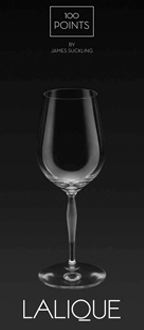
I incorrectly stated in past issues of the PinotFile that Jim Ball Vineyards was sold to Champagne Louis Roederer. Neither the trademark Jim Ball Vineyards nor the corporation Jim Ball Vineyards, Inc., were ever sold to Roederer. The corporation is still privately held by Mr. Ball, the label is still owned by Jim Ball Vineyards, Inc., and the trademark is still owned by Mr. Ball and Jim Ball Vineyards, Inc.. The Four Dog Ranch in Anderson Valley associated with Jim Ball Vineyards, Inc. was sold in 2011. The Jim Ball Vineyards website is www.jimballvineyards.com. Three 2009 Jim Ball Anderson Valley Pinot Noirs (Signature, Boonville and les Pintades) are currently offered on the website.
Splitting Hairs
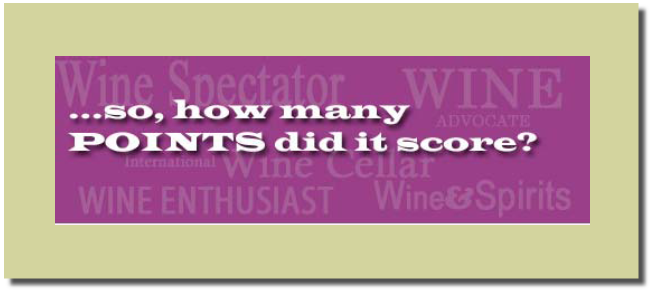 When I launched the Pinotfile over ten years ago, I did not include a quality designation or score for the wines I reviewed. Rather, I tried to describe my drinking experience and let the reader take it from there. I soon received considerable backlash from readers who wanted to know specifically which Pinot Noir wines I didn’t like, those I liked, and those I really liked. I then grudgingly developed the quality scale that I use today. It was much easier then to evaluate wines within that scale. It is a lot harder to judge the quality of American Pinot Noir these days. This vixen of a grape has let success go to her head, and she is so taken by herself, she now struts out impeccably made up, correctly groomed, and tastefully clothed for practically every bottle opening. Pinot Noir is now produced by more American wineries than any other red varietal. It is the wine that winemakers want to make and the wine that consumers want to drink. It was not that long ago, say 25 years, that consistency was the Achilles heal of American Pinot Noir. I personally spent a small fortune on disappointing Pinot Noir throughout those formative years. Today, practically every winery I know has a Pinot Noir that has scored 90 or above by some blog, magazine, retailer, website or competition. There are very few bad Pinot Noirs from reputable sources on the market today. The leap in quality of American Pinot Noir has challenged the wine critic to be more vigilant, circumspect and deprecating, more fine tuned to small differences in quality. It has become a game of splitting hairs. Despite this, the increasing level of quality has caused ratings to gradually rise, with more Pinot Noirs than ever receiving higher scores and accolades. Years ago we couldn’t have imagined American Pinot Noir receiving scores of 99 (the 2007 Marcassin Marcassin Vineyard Sonoma Coast Pinot Noir) or 100 (the 2007 Williams Selyem Estate Vineyard Russian River Valley Pinot Noir). For consumers, this situation is heavenly. No wringing hands over what to buy. For wine critics, the perspective is daunting, but not insurmountable. The solution is simple. We should concern ourselves more with differences among Pinot Noir wines than what is good, better or best. Wine writers need to praise diversity rather than split hairs about small differences in quality that are neither important or noticeable to most people. Two notable wine critics support my position. Jasper Morris, MW, has eloquently stated, “I remain unconvinced that there is a single definition of ‘Pinosity’ - the charm is that the grape can wear so many different clothes, and sometimes none at all.” Respected English wine writer and critic, Hugh Johnson, has also chimed in about the task of reviewing wines. He professes that, “His own life’s work is chiefly concerned with the word ‘different,’ and not predicated on the fact that there is ‘better’ or ‘worse.’” |